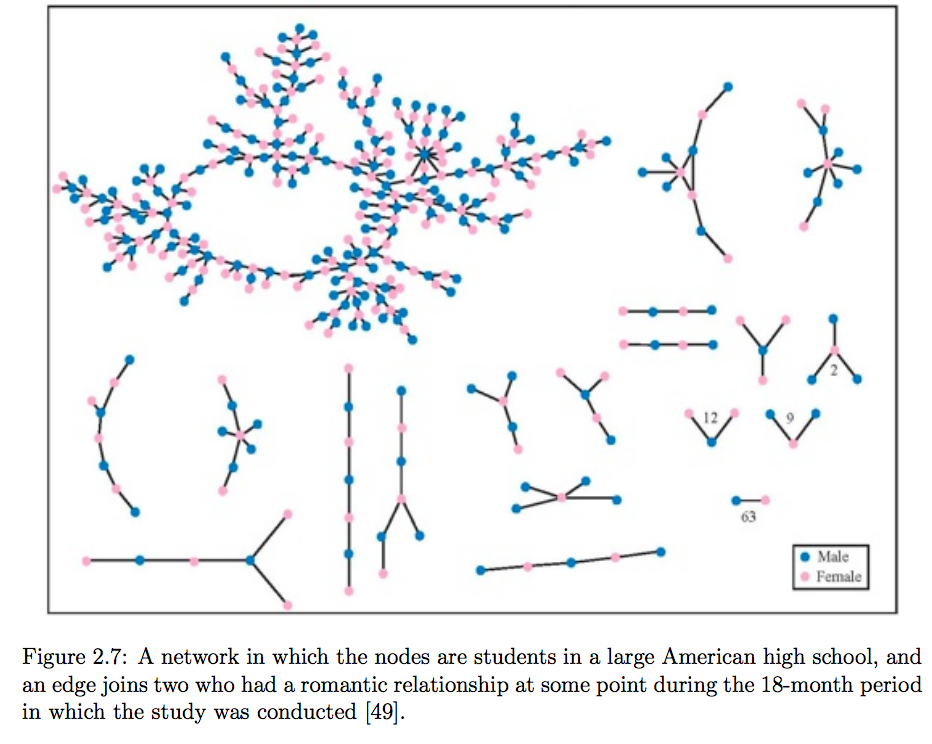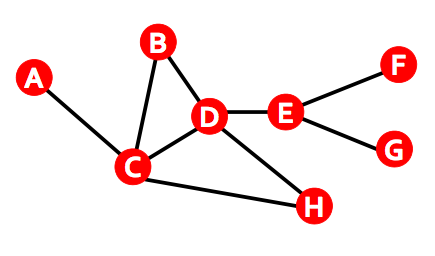CS579: Lecture 03¶
Representing Graphs
Dr. Aron Culotta
Illinois Institute of Technology
(Slides inspired in part by Jure Leskovec and Easley & Kleinberg)
Terminology¶
- Graph: A way to represent objects and their relations
- Node: represents an object
- Edge: represents a relation between two nodes.
- Neighbor: Two nodes are neighbors if they are connected by an edge.
- Directed Graph: Represents asymmetric (one-way) relationships
- Undirected Graph: Represents symmetric relationships
Examples of directed and undirected graphs?
Path: A sequence of nodes in which each consecutive pair are neighbors
- E.g., $A,B,C$ in Figure 2.1(a)
Cycle: A path of at least 3 edges, with first and last nodes the same.
- E.g., $B,C,D$ in Figure 2.1(a)
Connected: A graph is connected if there exists a path between each pair of nodes.
- Example of a graph that is not connected?
Connected Component: A maximal subset of nodes such that each pair of nodes is connected
- Is the global friendship network connected?
Giant Connected Components¶

Node Degree: Number of neighbors of a node.
- For directed graphs, distinguish between in-degree and out-degree
import matplotlib.pyplot as plt
%matplotlib inline
sizes = range(1000)
plt.plot(sizes, [s*(s-1)/2.0 for s in sizes])
plt.xlabel('number of nodes')
plt.ylabel('maximum number of edges')
plt.show()
Luckily, most real-world graphs are extremely sparse.
- E.g., you are probably not friends with over 1,000 people.
Measuring Graphs¶
- How can we summarize a graph?
- Besides number of edges and number of nodes.
- Allows us to determine if two graphs are "similar"
Degree distribution¶
- Probability that a randomly chosen node has degree $k$
- $N_k$: number of nodes with degree $k$
- $P(k) = $ ?
# See Karate Club network: http://vlado.fmf.uni-lj.si/pub/networks/data/Ucinet/UciData.htm#zachary
# First, we print the degree for each of the 34 nodes.
import warnings
warnings.filterwarnings("ignore")
import networkx as nx
G=nx.karate_club_graph()
nx.draw(G, with_labels=True)
# dict from node id to degree
degrees = nx.degree(G)
degrees
{0: 16,
1: 9,
2: 10,
3: 6,
4: 3,
5: 4,
6: 4,
7: 4,
8: 5,
9: 2,
10: 3,
11: 1,
12: 2,
13: 5,
14: 2,
15: 2,
16: 2,
17: 2,
18: 2,
19: 3,
20: 2,
21: 2,
22: 2,
23: 5,
24: 3,
25: 3,
26: 2,
27: 4,
28: 3,
29: 4,
30: 4,
31: 6,
32: 12,
33: 17}
# Count number of nodes with each degree value.
from collections import Counter
degree_counts = Counter(degrees.values())
degree_counts
# e.g., 11 nodes have degree of 2
Counter({1: 1,
2: 11,
3: 6,
4: 6,
5: 3,
6: 2,
9: 1,
10: 1,
12: 1,
16: 1,
17: 1})
# Now, let's plot the bar graph for the distribution of P(k)
# probability of a node having degree k
p_k = [(degree, count / len(G.nodes()))
for degree, count in degree_counts.items()]
p_k = sorted(p_k)
print(p_k[:5])
ks = [x[0] for x in p_k] # Get the first element of each tuple (the degree)
# Plot the bar chart.
x_pos = range(len(ks))
plt.xticks(x_pos, ks)
plt.bar(x_pos, [x[1] for x in p_k], align='center', alpha=0.4)
plt.xlabel('$k$')
plt.ylabel('$P(k)$')
mean = 1. * sum(degrees.values()) / len(G.nodes())
plt.title("Degree Distribution for Karate Network (mean=%.2f)" % mean)
plt.show()
[(1, 0.029411764705882353), (2, 0.3235294117647059), (3, 0.17647058823529413), (4, 0.17647058823529413), (5, 0.08823529411764706)]
- We'll see a lot of these.
- The mean value of a long-tailed distribution is often misleading.
Diameter: The maximum shortest-path between any pair of nodes.
Average path length: The average shortest-path between any pair of nodes (in one component).
Clustering coefficient: The fraction of a node's neighbors that are neighbors
(number of neighbor-neighbor links divided by number of possible neighbor-neighbor links)
- $e_i$: number of edges between neighbors of node $i$
- $k_i$: degree of node $i$
Average Clustering Coefficient:
$$C = \frac{1}{N}\sum_i C_i $$
What is clustering coefficient of node D?
$k_D=4, e_D=2, C_D=4/12 = 1/3$
...of node B?
$k_B=2, e_B=1, C_B=2/2 = 1$
# dict from node id to clustering coefficient.
import numpy as np
# np.mean(list(nx.clustering(G).values()))
nx.clustering(G)
{0: 0.15,
1: 0.3333333333333333,
2: 0.24444444444444444,
3: 0.6666666666666666,
4: 0.6666666666666666,
5: 0.5,
6: 0.5,
7: 1.0,
8: 0.5,
9: 0.0,
10: 0.6666666666666666,
11: 0.0,
12: 1.0,
13: 0.6,
14: 1.0,
15: 1.0,
16: 1.0,
17: 1.0,
18: 1.0,
19: 0.3333333333333333,
20: 1.0,
21: 1.0,
22: 1.0,
23: 0.4,
24: 0.3333333333333333,
25: 0.3333333333333333,
26: 1.0,
27: 0.16666666666666666,
28: 0.3333333333333333,
29: 0.6666666666666666,
30: 0.5,
31: 0.2,
32: 0.19696969696969696,
33: 0.11029411764705882}
plt.hist(list(nx.clustering(G).values()), bins=10)
plt.xlabel('clustering coefficient')
plt.ylabel('count')
plt.show()
plt.figure()
plt.plot(sorted(list(nx.clustering(G).values())), 'bo-')
plt.xlabel('rank')
plt.ylabel('clustering coefficient')
plt.show()
plt.figure()
plt.scatter(list(nx.degree(G).values()), list(nx.clustering(G).values()))
plt.xlabel('degree')
plt.ylabel('clustering coefficient')
plt.show()
